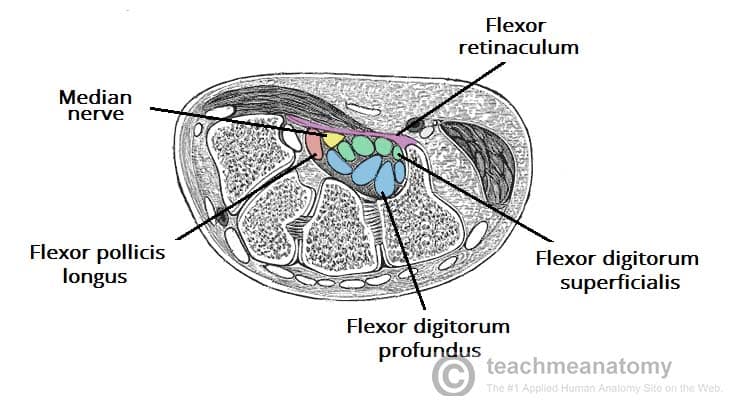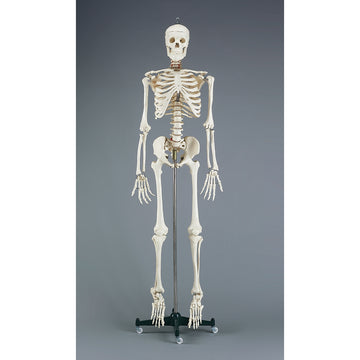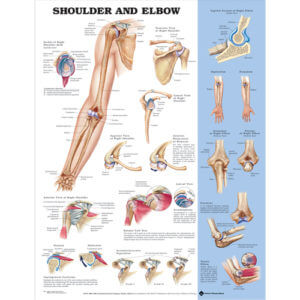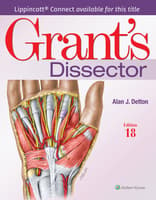Understanding Carpal Tunnel Syndrome Chart – MEDELCO
$ 2.99 · 4.7 (528) · In stock

Defines carpal tunnel syndrome (cts) and nerve compression syndrome. Shows the carpal tunnel and cross sections of a normal wrist and one with cts. Causes, risk
Defines Carpal Tunnel Syndrome (CTS) and nerve compression syndrome. Shows the Carpal Tunnel and cross sections of a normal wrist and one with CTS. Causes, risk factors, symptoms are listed. Management techniques and healthy lifestyle changes are also covered.
Classic illustrations by Peter Bachin. Shows anterior and posterior views of the muscular system. Also illustrates right half of the diaphragm, muscles of the posterior abdominal wall, and muscles of the right and right foot.
One of our most popular charts! Shows right lateral view of the vertebral column with markings to show location of atlas & axis, cervical, thoracic & lumbar vertebrae, and sacrum and coccyx. Provides various views of atlas & axis, second lumbar vertebra, fifth cervical vertebra, seventh and eleventh thoracic vertebrae, and sacrum and coccyx.
- Flexible spine with pelvis, movable femoral heads, occipital bone, vertebral artery and dorsal herniated disc between the 4th and 5th lumbar vertebrae
- Size 32 tall
- Includes chrome stand as shown
- Articulated adult human skeleton for teaching purposes
- Arms and legs are removable
- Skull dissects into 3 parts with the mandible on spring (32 teeth)
- Mounted with a metal rod extending from sacrum on mobile stand
- Size 5'5 tall
- Life size, economical articulating adult plastic skeleton is ideal for teaching the basics of anatomy
- Arms and legs are removable
- Features nerve branches, vertebral artery, and herniated lumbar disk. Skull includes movable jaw, cut calvarium, suture lines and 3 removable lower teeth
- Stand included
- Size 5'6 tall
Shows normal anatomy, including bones, ligaments, muscles, nerves and blood vessels. Illustrates and describes common acute fractures, such as Colles' Barton's, Smith's and radial fractures. Also shows and defines injuries such as carpal tunnel syndrome, osteoarthritis, rheumatoid arthritis and various finger maladies (trigger finger, ganglion cyst, Dequarvien's tendonitis and bursitis). Illustrates movement of about the wrist and fingers: flexion, extension, hyperextension, supination, pronation and thumb opposition.
- Chart set includes 2 charts: Trigger Points: Torso and Trigger Point: Extremities.
- Each chart illustrates and labels the muscles affected by trigger points.
- Shows trigger point locations with primary and secondary pain sensitive zones.
- Includes a legend which explains how to identify particular trigger points and their pain zones.
Shows a medial and lateral view of the bones and ligaments of the foot and ankle. Illustrates nerve and blood supply to this region, including the plantar view of arteries and nerves. Shows common fractures and sprains and anterior impingement syndrome.
Illustrates general hip anatomy including bones, muscles, arteries, veins and nerves. Shows anterior, posterior, and lateral (opened) views of the hip joint. Covers blood supply and injuries such as intertrochanteric fracture, femoral neck fracture and dislocation. Illustrates hip joint fractures & repair and total hip arthroplasty (replacement).
Main image shows the bones, muscles, ligaments, veins and arteries of the shoulder. Illustrates posterior, lateral, anterior and superior views of the shoulder anatomy, as well as the socket of a normal shoulder joint. Shows impingement syndrome, rotator cuff tear, trauma (such as proximal humeral fracture and acromioclavicular separation), and bicipital tendon problems. Also illustrates instability such as anterior dislocation of the humerus, Bankart lesion, and Hill Sachs formation.
Classic illustrations by Peter Bachin. Shows system on body. Illustrates heart (right interior, left interior, and posterior views), heart in systole, female pelvis, base of the brain, and branches of abdominal aorta and portal vein.
Illustrates spinal nerves, cranial nerves and diagrams the portion of the thoracic spinal cord with spinal nerves. Also shows spinal cord segments, cutaneous distribution of spinal nerves and dermal segmentation.
Classic illustrations by Peter Bachin. Illustrates nerves in the body, brain, midbrain, medulla oblongata and spinal cord. Also shows spinal meninges, intercostal nerves and sagittal section of female pelvis.
Illustrates foot and ankle anatomy including bones, muscles and tendons. Shows medial, frontal, lateral, and plantar views as well as a cross section. Illustrates supination and pronation, hammertoe, bunion, sprains, fractures and fracture fixation.
Featuring updated illustrations and additional detail, the second edition of this chart shows skeletal hip and knee anatomy, as well as additional detail of the hip joint capsule, acetabulum, bursae, and ligaments of the knee.
Common hip and knee inflammations are described in a brief and informative paragraph. Each illustration shows the disease in context and provides a close-up of the inflamed area.
Shows anterior view of normal knee anatomy (patella removed), as well as oblique and posterior views. Illustrates traumatic knee injuries, meniscus, types of meniscus tears, and symptoms of damaged menisci. Also shows various sports-related ligament injuries.
Illustrates general shoulder and elbow anatomy. Shows anterior, posterior, lateral, and superior view of the shoulder. Also shows the socket of shoulder joint anterior and disclocation of humerus. Illustrates impingement syndrome and acromioplasty. Shows sagittal view of the elbow, as well as supination, pronation and superior views of extension and flexion. Illustrates elbow fractures and tennis elbow.
Classic illustrations by Peter Bachin. Shows anterior, lateral and posterior views of the skeletal system. Also illustrates portion of long bone, auditory ossicles, ligaments of the right hand (dorsal and palmar views), ligaments of the right foot (dorsal and plantar view) and the right knee joint (anterior and posterior views).
Shows muscle and tendon anatomy of the hand and wrist. Illustrates dorsal view of bones and palmar view of carpal bones. Shows extension, flexion and range of movement of thumb. Provides views of cross-section of wrist, carpal tunnel syndrome, various types of fractures and tendon avulsion injuries.
Illustrates in detail the main joints affected by Osteoarthritis (OA) and Rheumatoid Arthritis (RA) - the hand and wrist, hip and knee. Shows bone spurs, narrowing of joint space, erosion of cartilage and swelling.
Shows location of various joints provides anterior and posterior views of the left shoulder, right hip, right knee and left elbow. Also illustrates lateral and medial views of the left elbow and ankle joint. Shows superficial volar, deep dorsal and superficial dorsal views of the left wrist.
Defines whiplash and shows hyperflexion, hyperextension, spinal ligaments, ligament damage, muscle injury and spinal cord injury.
Center illustration shows muscles, veins, nerves and arteries of the head and neck. Chart also shows bones, deep muscles and sensory nerves, internal carotid and vertebral arteries and deep structures. Illustrates horizontal and median sections.
Illustrates how one's posture changes due to the different types of spinal disorders. Also explains how other diseases or disorders could cause back pain. Shows tumors on the spinal column, ilium, sacrum, and spinal cord. Also illustrates arthritis of the hip, herniated disc, fractures of the vertebrae and sacrum, and the effects of osteoporosis on bones. Shows the anatomy of a typical vertebra and an intervertebral disc. Explains the function of the intervertebral disc.
- This model features 4 pairs of life-size lumbar vertebrae in 3 stages of degeneration
- Shown are a normal pair of lumbar vertebrae, a pair with a bulging herniated disc, a vertebra set with bone and disc degeneration, and finally, advanced osteoporosis with serious bone compression and bone spurs
- Models do not dissect but can be removed for individual inspection and study
- Includes removable patient education cards
- Size: 3-1/2 x 3-1/4 x 3 each. Base: 5-3/4 x 10-1/2
- Life-size model of a right foot features the platar calcaneonavicular (spring) ligament with plantar fascitis. Also includes tibia, fibula, calcaneus, calcaneal (Achilles) tendon, deltoid ligament, lateral (collateral) ligament, plantar aponeurosis, cuneiform, phalanges, cuboid, navicular and metatarsal bones
- May be removed from base.
- Includes patient education card
- Size 9 x 2-/34 x 4
- Full-size right knee includes: femur, fibula patella and tibia. Lateral and medial meniscus, quadriceps femoris tendon, anterior cruciate, fibular and tibial collateral, patellar and posterior meniscofemoral ligaments
- Includes patient education card
- Size: 3-1/2 x 2-3/4 x 6
- Life size model of a left hand, wrist and forearm features: distal, middle and proximal phalanges of the thumb, metacarpal bones, joint capsule ligaments, thenar muscle, palmar carpal ligament, median nerve, flexor digitorum superficialis tendons, triquetrum, pisiform, hamate, hook of hamate, flexor profundus digitorum tendons, palmaris longus tendon, interossseous membrane, radius and ulna. Palmar carpal ligament lifts to show nerves and ligaments under it
- May be removed from base
- Includes patient education card
- Size 11-1/2 x 3-3/4x 1-1/4
- Full-size right elbow bone model includes: humerus, radius and ulna, joint capsule, annular ligament of radius, oblique cord, radial collateral and ulnar collateral ligaments
- Patient education card included
- Size: 8-1/2 x 2-1/4 x 4
All 4 of our basic joint models for one low price. Each model includes a patient education card and a stand. These models do not articulate.
- Full-size right hip with femur: Size: 5 x 4-3/4 x 8-1/4.
- Full-size right shoulder: Size: 5-1/2 x 6 x 6.
- Full-size right elbow bone model: Size: 8-1/2 x 2-1/4 x 4.
- Full-size right knee: Size: 3-1/2 x 2-3/4 x 6.
Internationally renowned physiotherapist Robin McKenzie provides n easy-to-follow method to prevent neck pain and relieve common neck pain problems.
Robin McKenzie's Treat Your Own Knee presents a mechanical background of knee pain together with self-management guidelines and an exercise program for pain sufferers.
Treat Your Own Knee can also be a valuable complement to physical therapy, chiropractic care or other manual therapy as it can relieve pain and prevent symptoms from recurring between visits.
Internationally renowned physiotherapist Robin McKenzie provides n easy-to-follow method to prevent neck pain and relieve common neck pain problems.
Robin McKenzie's Treat Your Own Shoulder teaches the importance of stretching and how regular practice of proper positioning helps treat and prevent shoulder area pain.
This Book demonstrates techniques on how to apply treatment to yourself whenever pain arises and offers tipswhich help prevent or reduce the onset of pain.
Internationally renowned physiotherapist Robin McKenzie provides an easy-to-follow method to prevent neck pain and to relieve common neck pain problems.
Help yourself to a pain-free neck. The simple and effective self-help exercises in Robin McKenzie's Treat Your Own Neck have helped thousands find relief from common neck pain. This Comprehensive system for neck self-management provides relief and prevention of common neck pain and injury.
Treat Your Own Neck can also be a valuable complement to physical therapy, Chiropractic care or other manual therapy as it can relieve pain and prevent symptoms from recurring between visits.
Internationally renowned physiotherapist Robin McKenzie provides an easy-to-follow method to prevent back pain and to relieve common back pain problems.
Help yourself to a pain free back. This easy-to-follow book presents over 80 pages of education and clinically proven exercises. The simple and effective exercises in Robin McKenzie's Treat Your Own Back have helped thousands worldwide find relief from common low back and neck pain.
This book helps you understand the causes and treatments, along with a system of exercises that can help you relieve pain and prevent recurrence.
- 8th Edition
- 72 pages

Anatomy Chart Understanding Carpal Tunnel
Understanding Carpal Tunnel Syndrome Anatomical Chart

Carpal Tunnel Syndrome - StatPearls - NCBI Bookshelf

The Carpal Tunnel - Borders - Contents - TeachMeAnatomy

Understanding Carpal Tunnel Syndrome Chart – MEDELCO

Understanding Carpal Tunnel Syndrome

Therapy Equipment & Clinical Supplies Canada – MEDELCO

Carpal Tunnel Syndrome Anatomy Poster

Understanding Carpal Tunnel Syndrome
